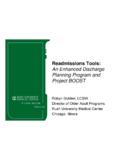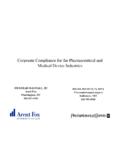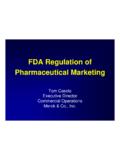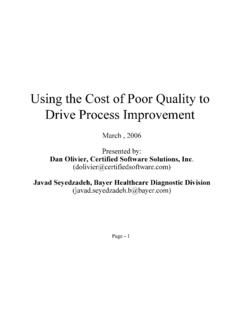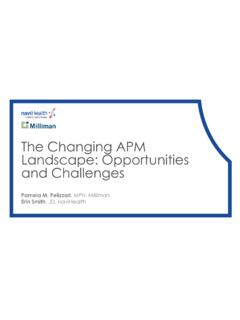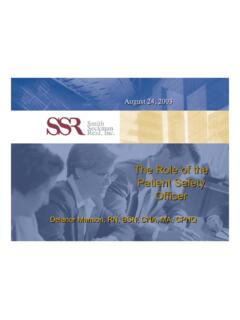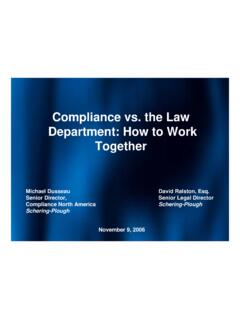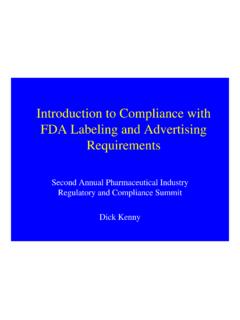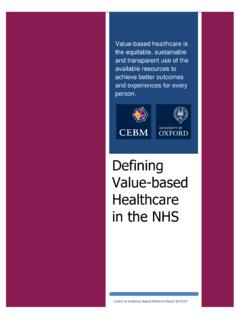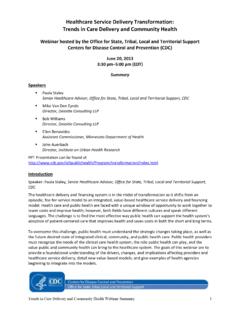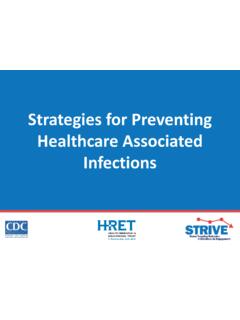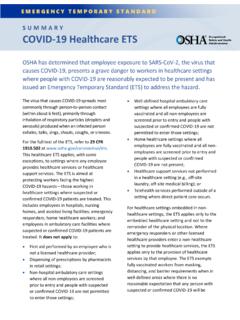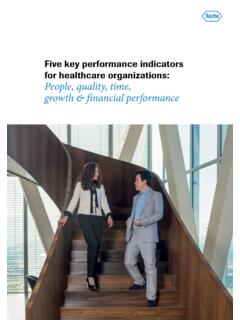Transcription of Fair Market Value and Payments to Healthcare Professionals
1 Fair Market Value and Payments to Healthcare Professionals How Should We Determine What We Pay? Huron Consulting Services LLC. All rights reserved. Contact Information Debjit Ghosh Life Sciences Practices Huron Consulting Group 1120 Avenue of the Americas New York, NY 10019. (P) 973 477 3992. 2. The Regulatory Environment 3. Evaluating the Appropriateness of Payments With increased prosecution targeting Medical Device, Pharmaceutical and Biotechnology companies under the Anti-Kickback Statute and the False Claims Act, formal assessments of bona fide service and fair Market Value . can be a critical step in substantiating the appropriateness of Payments by manufacturers to various constituents in the Healthcare supply chain. Sales & Marketing Healthcare Professionals Training Medical Education Grants Commercial Contracting Payors Distributors Authorized Agents Clinical Research Institutions Hospitals Clinics Physician Practices 4. The Regulatory Environment Regulatory bodies are increasingly scrutinizing Payments made by Medical Device, Pharmaceutical and Biotechnology Companies to Healthcare Professionals : Centers for Medicare and Medicaid Services.
2 HHS Office of Inspector General;. Department of Justice;. State Attorneys General. Key risk areas: Are these Payments potential inducements for product selection? Could these Payments be construed as a kickback or part of a quid pro quo . arrangement? Did these Payments potentially initiate use of the product inappropriately? Risk management for Medical Device Companies: Demonstrate that the Payments are for bona fide purposes . Demonstrate that the Payments represent fair Market Value . 5. Direct Payment Risks to Healthcare Professionals Direct Payments to or involving Healthcare Professionals generally draws the greatest amount of scrutiny. Payments to any individual in a position to influence a referral is a key compliance risk area. Regulators are broadly concerned about gifts, hospitality, and charitable contributions. However, fee-for-service arrangements are also of concern: Providing product training Participation in Advisory Boards Payments to act as a Speaker or be involved in Speaker Training Market Research Consulting arrangements Medical Education or CME events Manufacturers must also be concerned with Agents and Authorized Representatives.
3 6. The Broad Application of Fair Market Value . The principles of demonstrating bona fide purpose and fair Market Value . should not be limited to direct Payments to Healthcare Professionals , but to all Payments made into the Healthcare supply chain. Regulators are issuing broad document requests to examine all types of financial relationships between life science companies and their partners in the Healthcare system. This could include any entity that either employs or is a conduit to a Healthcare professional : Research Grants Medical Education and Training Contracts with Distributors 7. Implications to State Law Compliance Pharmaceutical companies are facing a myriad of compliance challenges from various State Laws that legislate compliance for sales & marketing activities such as: CA, MN, VT, ME, etc. Although most laws are strictly directed at Pharmaceutical Companies, a number of State Attorneys General along with the OIG have made references where they do not draw distinctions for the purposes of sales & marketing.
4 If the State's expand their compliance tracking and reporting initiatives to include Medical Device Manufacturers, then formal tracking of spending on Healthcare Professionals will be a critical activity. Distinguishing fee-for-service Payments to Healthcare Professionals will be a critical as each of the State laws provide tracking and reporting exemptions for bona fide Payments that do not exceed fair Market Value . 8. The Legal Framework 9. The Anti-Kickback Statue The anti-kickback statute is a criminal prohibition against Payments (in any form, whether the Payments are direct or indirect) made purposefully to induce or reward the referral or generation of federal Healthcare business . HHS OIG. Although liability under the anti-kickback statute ultimately turns on a party's intent, it is possible to identify arrangements or practices that may present a significant potential for abuse HHS OIG. Manufacturers, providers and suppliers of health care products and services frequently cultivate relationships with physicians in a position to generate business for them through a variety practices, including gifts, entertainment, and personal services compensation arrangements.
5 These activities have a high potential for fraud and abuse and, historically, have generated a substantial number of anti-kickback convictions HHS OIG. 10. The False Claims Act What does it prohibit? Any person who presents, or causes to be presented a claim for payment or approval to the federal government that was false or fraudulent and defendant acted knowingly violates that statute. What is knowingly? Has actual knowledge of the information: Acts in deliberate ignorance of the truth or falsity of the information; or Acts in reckless disregard of the truth or falsity of the information;. NO PROOF OF SPECIFIC INTENT TO DEFRAUD IS REQUIRED! What are the penalties? Civil penalty of not less than $5,500 and not more than $11,000 for each claim plus Up to 3 times the amount of damages which the government sustains. Who enforces the False Claims Act? The United States Department of Justice enforces the False Claims Act. Under the qui tam provisions of the False Claims Act, private parties who have direct knowledge of the fraud can file an action on behalf of the government.
6 These individuals are referred to as relators or whistleblowers.. They are like private attorney generals . Relators can proceed with a case even if the government declines to intervene in the case. Qui tam relators receive a portion of proceeds depending on level of involvement and other factor. 11. The Approach to Valuation 12. Fair Market Value Fair Market Value is often defined as: the price at which the items or services would be exchanged between a willing buyer and a willing seller, neither being under any compulsion to buy or sell and both having reasonable knowledge of the relevant facts, and without consideration of either party's position to make or influence referrals, to furnish items or services to, or otherwise generate business for the other party as of the Date of Valuation. 13. Performing a Bona Fide Service Fee Analysis Generally there isn't much purpose to determining fair Market Value if you have not determined if the fee is for a bona fide purpose.
7 Perform supporting analysis What is the specific purpose of the payment? Is there formal agreement/contract governing the service? Is the fee broken down to its basic components? Is it duplicative with any existing functions within the company or payment made by another part of the company? Is the payment directly related to the company's commercial or clinical strategy? Is there a formal process through which the payment is approved? Are there controls in place to prevent fraud, waste, and abuse? Document the process, purpose, need, payment, and service (PPNPS). 14. PPNPS 5 Critical Elements to Documentation Process Is there a formal process through which payment levels are determined through pre-specified criteria? Are the Payments pre-set and defined or can they be variable? Purpose Why is the payment necessary? What is the underlying purpose? Is the payment potentially duplicative? Is there a potential for fraud, waste, and abuse?
8 Need Why is the service necessary from this individual or company? How does it relate to the company's commercial or clinical strategy? Payment Was there a determination process to derive a fair Market Value range for the payment? Is there a process to track the totality of spend on a particular Healthcare professional ? Service Was the service actually performed? Was there a demonstrable outcome that resulted from the payment? 15. Assessing Fair Market Value . The HHS OIG has identified Payments to Healthcare Professionals as compliance risk areas; however, they do not establish fair Market Value payment rates nor define a procedure or calculation to derive this Value . Develop ranges of Fair Market Value payment rates to be used as a guideline in the establishment of service fee agreements. Regulatory agencies provide little guidance specific facts and circumstances dictate appropriate approach and methodologies. Typically, the cost and Market approaches are used to Value service agreements, with income approach utilized as corroboration.
9 Whenever possible, fair Market Value payment rates should be analyzed and developed using multiple valuation approaches. 16. Valuation Basics Three Established Approaches Cost build-up approach . In applying the cost approach to services, a cost build-up approach is often utilized. Under the cost build-up approach, actual or expected costs incurred are analyzed and an assumed profit level is estimated to derive an indication of the fair Market Value of the services. Income approach . In applying the income approach to services, analyses of various rates of return provide corroboration for estimated fair Market values. Market approach . In applying the Market approach we are looking for agreements involving the sale of similar services. This Market data is adjusted for significant differences. Based on types of services provided, data provided, pricing for services can greatly impact Value and lead to appropriate adjustments. Services provided by outside companies Outsourcing functions ( , sales force training, contract enrollment and administration, call center support, data fees).
10 Services performed in similar settings or environments; and Industry knowledge from other projects of a similar nature. 17. Performing Valuation Analysis Valuation theory provides three broad approaches to developing data and analysis pertinent to the goods or services that are being valued (Cost, Income, and Market ). However, valuation analysis itself is very specific to the facts and circumstances that are presented. Fair Market Value for one company may not represent fair Market Value for another. In general, a customized approach is developed to meet the specific valuation need. In most cases, one approach tends to emerge as the most appropriate methodology for the valuation analysis. In such cases, the other two approaches, when feasible are used to corroborate the analysis. Development of an appropriate fair Market Value payment rate generally considers the following: Understanding the nature of the contracted services, the competitive landscape of the marketplace, and analogous goods and services provided within the industry and from other industries.
